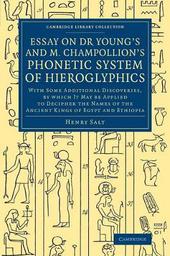
|
Essay on Dr Young's and M. Champollion's Phonetic System of Hieroglyphics: With Some Additional Discoveries, by Which It May Be
Paperback / softback
Main Details
| Title |
Essay on Dr Young's and M. Champollion's Phonetic System of Hieroglyphics: With Some Additional Discoveries, by Which It May Be
|
| Authors and Contributors |
By (author) Henry Salt
|
| Series | Cambridge Library Collection - Egyptology |
|---|
| Physical Properties |
| Format:Paperback / softback | | Pages:94 | | Dimensions(mm): Height 229,Width 152 |
|
| Category/Genre | Egyptian archaeology and Egyptology |
|---|
| ISBN/Barcode |
9781108078207
|
| Classifications | Dewey:493.111 |
|---|
| Audience | | Professional & Vocational | |
|---|
| Illustrations |
11 Line drawings, unspecified
|
|
Publishing Details |
| Publisher |
Cambridge University Press
|
| Imprint |
Cambridge University Press
|
| Publication Date |
4 December 2014 |
| Publication Country |
United Kingdom
|
Description
Appointed Britain's consul-general in Egypt in 1815, Henry Salt (1780-1827) involved himself deeply in the excavation of several historic sites and the collection of numerous antiquities. The most notable of these, found at Thebes, was the colossal bust of Rameses II which was acquired by the British Museum and is believed to have inspired Shelley's 'Ozymandias'. This 1825 publication, featuring Salt's careful reproductions and explanations of various inscriptions, made a valuable contribution to the understanding of Egyptian hieroglyphics. Following the innovative work on the Rosetta Stone carried out by Thomas Young, and the celebrated decipherment presented in 1822 by Jean-Francois Champollion, Salt helped to further elucidate the hieroglyphic alphabet, although later research has disproved some of his conclusions. A postscript notes how Champollion's 1824 Precis du systeme hieroglyphique des anciens Egyptiens (also reissued in this series) confirms several names of Egyptian gods and pharaohs which Salt had independently deciphered.
|